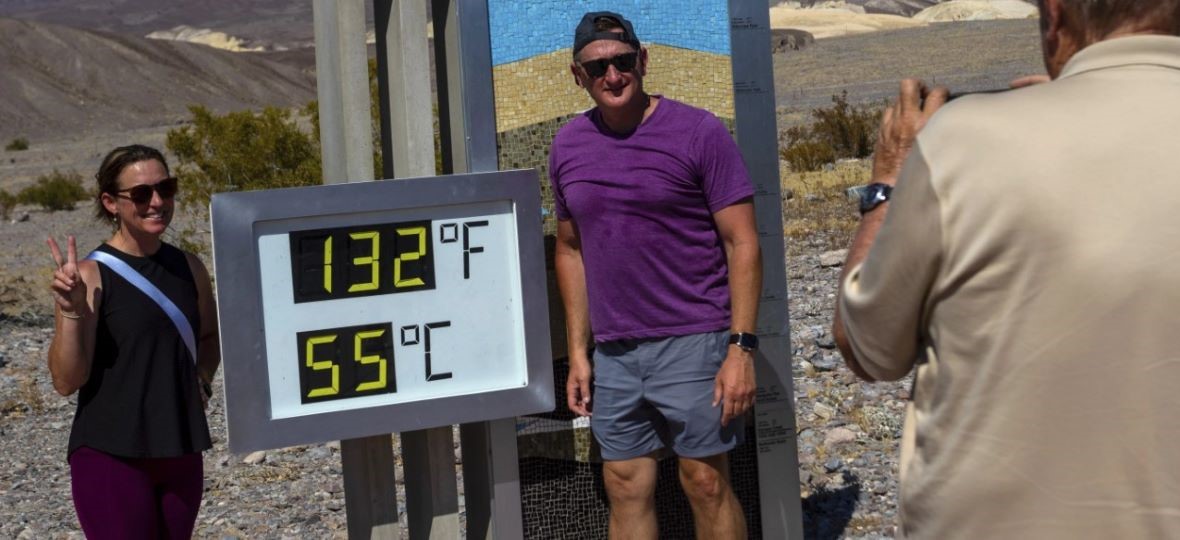After causing deaths and shattering records in the West and Pacific Northwest over the weekend, a long-running heat wave continued to grip Western Canada and much of the U.S. on Monday. Nearly two dozen daily temperature records – including one that had stood for almost 120 years – were broken in British Columbia, pushing the mercury over 40 C in some areas.
A summary from Environment Canada shows 22 daily high temperature records fell across the province on Sunday, including 38.3 C in the Kamloops area breaking the previous record of 35.6 for July 7 set in 1906.
Cache Creek, BC, was a hotspot on Sunday, with a daily high of 40.3 C, breaking the record of 36.9 set in 2015. And new daily records have also been set in the northeastern B.C. community of Fort Nelson, as well as Williams Lake in central BC, Smithers in the northwest, Nanaimo on Vancouver Island, and Gibsons on the Sunshine Coast.
The weather office had issued more than 40 heat warnings in BC by Sunday. Temperatures on Monday were forecast to hit 41C in the Interior village of Lytton, 27 C at Vancouver’s airport and 39 C in Kamloops.
The tiny community of Fort Liard, in the southwestern corner of the Northwest Territories, is forecast to hit 30 C until Wednesday, well above its average high of 23 C.
The heat wave comes as the global temperature in June was record warm for the 13th straight month and it marked the 12th straight month that the world was 1.5 degrees Celsius warmer than pre-industrial times, the European climate service Copernicus said.
US
Meanwhile, in the US, an excessive heat warning, the National Weather Service’s highest alert, was in effect Monday for portions of states including California, Nevada, Arizona, Oregon, Washington and Idaho, while parts of the East Coast as well as states including Florida, Georgia, Alabama and Mississippi were under heat advisories.
A high temperature of 53.3 C was recorded Saturday and Sunday at Death Valley National Park in eastern California, where a visitor died Saturday from heat exposure and another person was hospitalized, officials said. The two visitors were part of a group of six motorcyclists riding through the Badwater Basin area amid scorching weather, the park said in a statement.

“While this is a very exciting time to experience potential world record setting temperatures in Death Valley, we encourage visitors to choose their activities carefully, avoiding prolonged periods of time outside of an air-conditioned vehicle or building when temperatures are this high,” park Superintendent Mike Reynolds said.
Across the desert in Nevada, Las Vegas on Sunday set a record high of 120 F (48.8 C).
Triple-digit temperatures were common across Oregon, where several records were toppled, including in Salem, where on Sunday it hit 103 F (39.4 C), topping the 99 F (37.2 C) mark set in 1960.
Officials warned that heat illness and injury are cumulative and can build over the course of a day or days.
“Drink plenty of fluids, stay in an air-conditioned room, stay out of the sun, and check up on relatives and neighbours,” read a weather service advisory for the Baltimore area. “Young children and pets should never be left unattended in vehicles under any circumstances.”
Rare heat advisories were extended even into higher elevations including around Lake Tahoe, on the border of California and Nevada, with the weather service in Reno, Nevada, warning of “major heat risk impacts, even in the mountains.”
“How hot are we talking? Well, high temperatures across (western Nevada and northeastern California) won’t get below 100 degrees (37.8 C) until next weekend,” the service posted online. “And unfortunately, there won’t be much relief overnight either.”
More extreme highs are in the near forecast, including possibly 130 F (54.4 C) around midweek at Furnace Creek, Ca., in Death Valley. The hottest temperature ever officially recorded on Earth was 134 F (56.67 C) in July 1913 in Death Valley, though some experts dispute that measurement and say the real record was 130 F (54.4 C), recorded there in July 2021.

